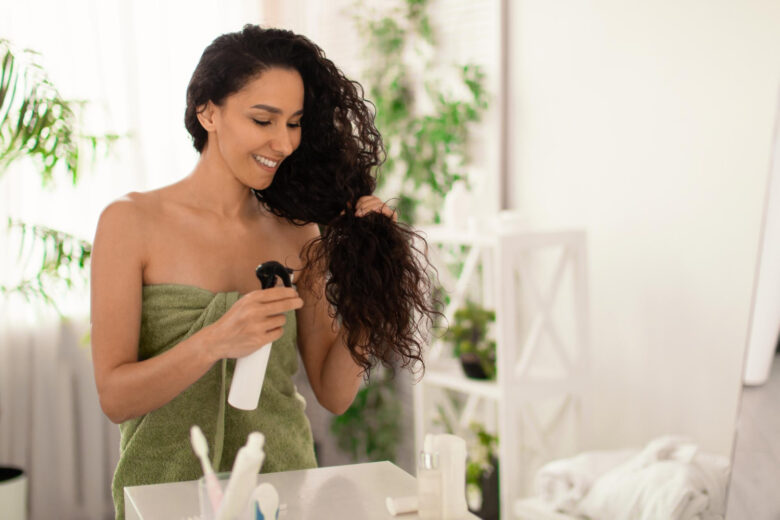Throughout history, curly hair has had a varied reception. At times, people desired it and spent hours trying to make curls in straight hair. Other times, certain types of curly hair were considered “unprofessional” or “unstylish”. But happily, today we are increasingly embracing individuality, and although there are always trends, we can’t say there’s a one-size-fits-all style anymore.
Unfortunately, many people with curly hair have grown up with the fad of straightening their hair, so even as adults they don’t really know how to take care of their hair, especially if it’s damaged in any way. That’s why we created this short but useful guide with tips on how to properly care for curly hair, but first let’s look at why curly hair needs different care than straight hair.

Source: freepik.com
Contents
Why is curly hair care different from straight hair?
Many people favor practical over theoretical knowledge, but understanding the differences can provide valuable insight into what kind of hair care is needed and which products to avoid. Caring for curly hair requires a unique approach compared to straight hair due to several inherent differences in texture, structure, and moisture needs.
Hair Structure and Texture
- Shape of the Hair Shaft: Curly hair is characterized by an oval or asymmetrical-shaped hair shaft, while straight hair tends to have a round shaft. This structural difference affects how the hair reflects light, making curly hair appear drier and more prone to frizz.
- Cuticle Layers: The cuticle layers of curly hair are often raised, making it more susceptible to damage and moisture loss compared to the smoother cuticle of straight hair. This makes retaining moisture in curly hair a constant challenge.
Moisture Retention
- Natural Oils Distribution: The bends and twists in curly hair slow down the distribution of natural oils from the scalp along the hair shaft. As a result, curly hair tends to be drier and more prone to frizz and tangles, requiring extra moisture and care.
- Prone to Dryness: Curly hair has a higher tendency to dry out, leading to increased frizz and a lack of definition in the curls. This necessitates the use of hydrating and moisturizing products to maintain the hair’s health and vitality.

Source: freepik.com
Styling Challenges
- Tendency to Tangle: The unique curl pattern of curly hair makes it more prone to tangling and knotting, requiring gentle detangling techniques and specialized products to minimize breakage. Some people choose to cut their hair short and wear curly short hair, as it is less prone to tangling, and also quite chic.
- Definition Maintenance: Styling curly hair often involves techniques aimed at enhancing and maintaining curl definition, which differs from the straightening and smoothing methods commonly used for straight hair.
Understanding these differences is crucial in tailoring a care routine that addresses the specific needs of curly hair. It involves using products and techniques that focus on retaining moisture, reducing frizz, and enhancing curl definition, ultimately preserving the natural beauty and health of your curly locks.
Daily Care Routine for Curly Hair
Now let’s get down to business: how to care for your curly hair. First of all, we recommend that you identify what type of curly hair you have, because depending on the type of curl, some of the care needs may vary. Taking care of curly hair involves a daily routine focused on preserving moisture, enhancing definition, and preventing frizz. Here are key steps to incorporate into your daily regimen:

Source: freepik.com
Cleansing: Shampooing and Conditioning
- Sulfate-free Shampoos: Begin your routine with a sulfate-free or mild shampoo. Harsh sulfates can strip natural oils, causing dryness and frizz. Opt for products that gently cleanse without compromising moisture.
- Conditioning: Follow up with a rich, hydrating conditioner. Apply it generously, focusing on the mid-lengths to ends of your hair. Use your fingers or a wide-tooth comb to detangle gently. For added hydration between washes, consider using a leave-in conditioner to keep your curls nourished and manageable.
Drying Techniques
- Avoid Towel Drying: Traditional towels can roughen up the hair’s cuticle, leading to frizz. Instead, opt for a microfiber towel or an old cotton t-shirt to gently blot excess water. Avoid rubbing or wringing out your hair to prevent breakage.
- “Plopping” Technique: Experiment with the “plopping” method. After applying your styling products, wrap your hair in a cotton t-shirt or microfiber towel. This technique helps enhance curl definition and reduces frizz by allowing the curls to set naturally.
Styling Tips
- Curly-Hair Specific Products: Choose styling products designed explicitly for curly hair. Look for gels, creams, or mousses formulated to define curls without weighing them down. Apply these products when your hair is wet, ensuring even distribution from roots to ends.
- Application Technique: Apply the products by gently scrunching or using the “praying hands” technique. Scrunching helps encourage curl formation, while the “praying hands” method involves smoothing products over sections of hair to minimize frizz and define curls.

Source: freepik.com
Since the number one problem for people with curly hair is dryness and frizz, prioritize moisture retention and gentle treatment in your daily routine. Remember, the journey to well-nourished, defined curls may involve experimentation to find the perfect routine for your hair type and preferences. Treat this process as an exploration and allow yourself the freedom to discover what works best for you.
